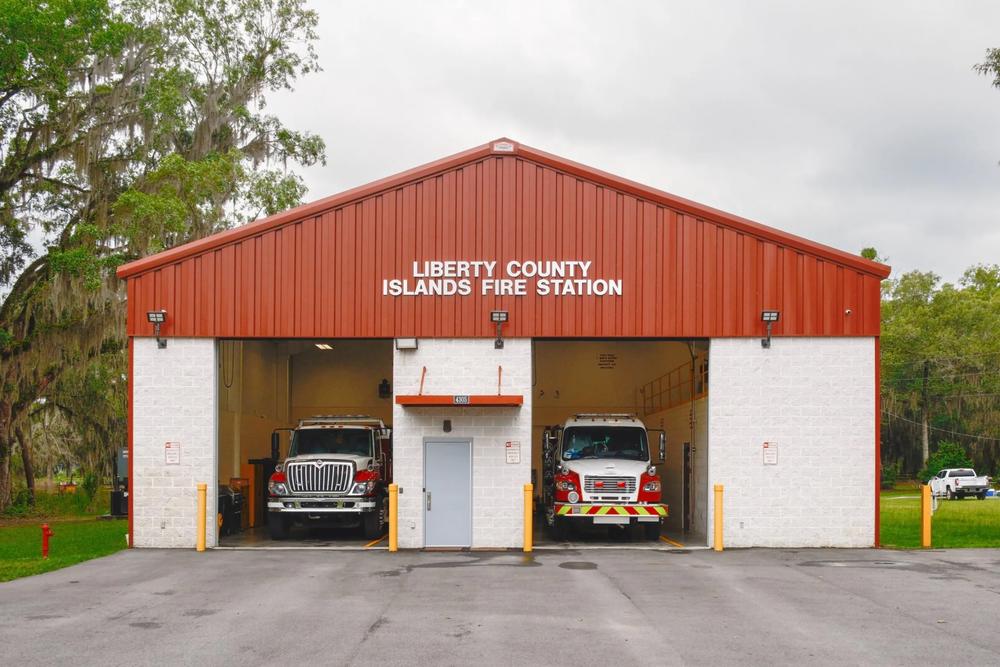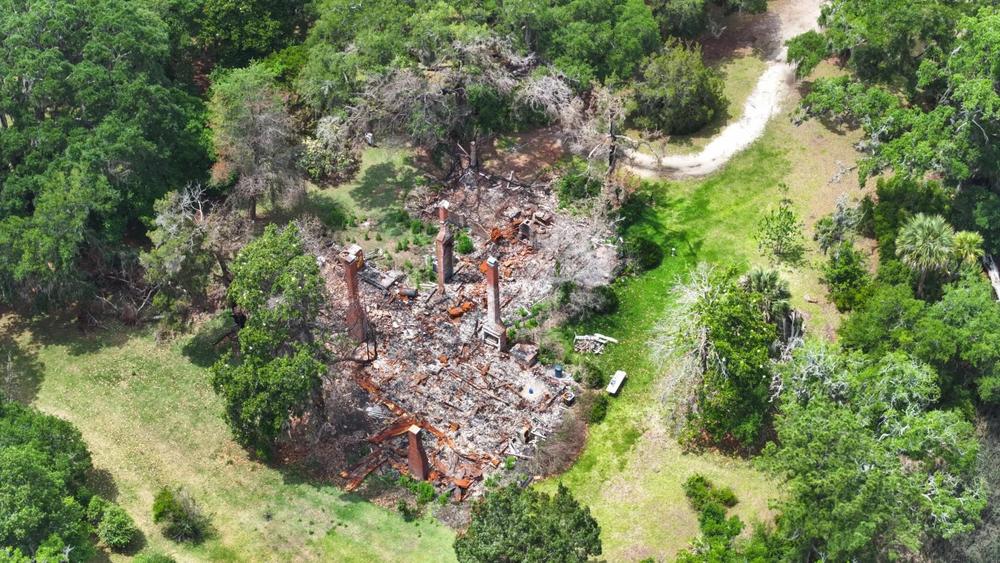
Caption
The Islands Fire Station, built in 2021, is a small fire station meant to service the wide expanses of east Liberty County and Tradeport East. Officials say it has no water tank of its own.
Credit: Justin Taylor/The Current

The Islands Fire Station, built in 2021, is a small fire station meant to service the wide expanses of east Liberty County and Tradeport East. Officials say it has no water tank of its own.
Jake Shore, The Current
Spurred by hopes of an economic boom, Liberty County commissioners over the last several years have rezoned thousands of acres of fallow farmland and forest east of I-95 to build warehouses and industrial zones.
Yet local officials haven’t shown the same zeal to ensure that the businesses coming to the county and thousands of residents already living there will be adequately protected if fire breaks out, according to a five-month investigation by The Current.
More than one-third of the county fire department remains part-timers despite the county transition to a full-time force in 2020. Although the budget has increased 1,630% in six years, the department lacks basic equipment to stop a two-story house fire. Standard safety plans, including how to respond to specific types of fires and a map of fire hydrant locations, don’t exist.
This lack of planning had disastrous results in November, when one of Liberty County’s oldest historic homes incinerated over a 12-hour period. Firefighters showed up to the property owned by Scott and Meredith Belford without enough water to manage the blaze and could not draw water from other available local sources, including the marsh or swimming pool located on the property, due to a lack of equipment.
In their after-action reports, several firefighters said a lack of crisis management, water and equipment were critical points of failure. Liberty County Fire Services Chief Brian Darby omitted mention of these issues in his final report to the state fire marshal.

The historic home of Scott and Meredith Belford on Springfield Plantation burned down on Nov. 20, 2022. The Belfords blame a lack of leadership and crisis management by Liberty County Fire Services Chief Brian Darby.
In the aftermath of the Belford blaze, senior county officials have shied away from publicly explaining the county’s fire safety plans, despite rising local concern.
County Manager Joey Brown recommended to the head of the County Commissioners not to make Darby available for questioning during the monthly public meeting held by the elected body, according to a Nov. 23 email exchange reviewed by The Current. “Probably not advisable,” Brown wrote to Donald Lovette.
Darby, who previously worked as a U.S. Army fireman before taking over the county agency in 2017, did not respond to numerous requests for comment from The Current over the past four months.
Brown, who agreed to speak on these issues with The Current in May after multiple interview requests, defended the fire chief and the county’s safety record.
He described the Belford fire as complex, saying no one, not even the country’s best fire department, could have saved the historic residence. He thinks criticism that the county had ignored standards for fire prevention is unfair.
“Our focus has definitely been getting boots on the ground, getting people to respond to fires, getting equipment to fires, because that’s the most important thing. Next year’s budget takes us another step further and starts to get us into some planning,” according to Brown.
The waterways of eastern Liberty County are home to families whose lineages stretch back to the Revolutionary War as well as newcomers eager for serenity offered by the salt marshes and woods around Sunbury, Colonel’s Island and Yellow Bluff.

The two-lane Islands Highway is the only way in or out of East Liberty. Residents have expressed fears that rapid warehouse development will create excessive traffic and public safety delays on Islands Highway.
From the early 1990s to 2018, the area east of I-95 was served by a volunteer fire department run by resident Joe Martin. His force had eight volunteer firefighters and covered over 800 homes from two fire stations, according to Allen Davis, who served on a county committee to assess fire safety.
In 2017, Liberty County commissioners expressed concern about the quality of its volunteer departments, citing statisticsthat showed close to half of the emergency calls to Midway and east Liberty’s volunteers went unresponded. After Martin retired in 2018, the county consolidated fire coverage to professionalize the force as the county grew, according to Brown, the county manager.
Liberty County took over fire coverage of five other volunteer agencies as well, but the handoff in east Liberty was rocky.
Residents awoke on New Year’s Day of 2019 without fire coverage and discovered that the closest fire station was at least 15 miles away, according to a report in the Coastal Courier newspaper.

Liberty County Fire Services Chief Brian Darby
Darby became the focus of criticism from residents a year-and-a-half into his tenure, according to press coverage at the time, especially over decisions about equipment.
County officials voted to lease some equipment from the defunct volunteer fire department for the newly professional agency run by Darby, but not the ladder trucks because they were in disrepair, according to Brown.
Darby’s budget in 2018 was small – just $272,000, with a staff of 16 part-time firefighters. Since then, the county has made large investments in the department’s budget every year, to its current $4.7 million.
By 2022 the force was budgeted for 54 staff, including the chief, who makes $88,233 per year. Part-timers made up 42% of the department.
The county still lacked a ladder truck.
Brown said that was due to price hikes caused by the Covid-related supply shortages. The county tried unsuccessfully to get a federal grant to buy one, he said.
Even as Darby struggled to staff and equip the expanded fire department, county officials picked up the pace of their economic development plans.
Since 2004 the Liberty County Development Authority has been marketing the eastern area of I-95 as a hub for logistics companies. The Tradeport East Logistical Center landed its first major client, Target Corp., a year later for a 1.5 million-square-foot distribution center.

In 2005, Liberty County wooed Target Corp. to build a 1.5 million-square-foot distribution center in its Tradeport East site. It began a wave of logistical industry business in the region, pushed for by county officials.
Tradeport East has since added more warehouse tenants, including two tire companies and an ATV and dirt bike distributor.
Since January 2022, Liberty officials have approved at least 16 new warehouses in the east Liberty corridor, according to a review by The Current.
Growth has animated many local residents. Some have complained about the county’s lack of planning to handle the growing heavy truck traffic to their once-tranquil neighborhoods. Others, like David Kay, have worried about a lack of attention to fire safety.
At a July 2022 county commission meeting, Kay spoke out to oppose a plan to rezone over 400 acres next to Tradeport East for more warehouses.
Building warehouses there would be a violation of national fire and insurance recommendations, Kay said. Those codes require a four-minute response time to the warehouses and a ladder truck to respond – both standards that Liberty County Fire Services wouldn’t be able to meet.
“Liberty County is putting employees, firemen, first responders and the community at risk,” Kay told the county commissioners. “There’s nobody that can respond, and I don’t think that Liberty County has a ladder truck.”
At the time, the county had not updated its fire safety plan in over a decade. Liberty’s fire department also lacked community risk assessments and standard of cover reports.
Standard of cover reports help departments foresee special hazards and plan the department’s response. It is recommended by the National Fire Protection Association and considered standard operating procedure by other regional fire departments.
“I would say it’s a best practice. But most fire departments are going to have them,” Chatham Emergency Services Chief of Fire James Vickers said.
“You basically map out your response area, and decide the challenges and how you’re going to approach mitigating those challenges, if at all possible,” Vickers said. “And then you take care of all that (and) you put it in the standard of cover.”

While approving construction of 16 warehouses since January 2022, Liberty County does not have a map of where its fire hydrants are located. County Manager Joey Brown said they are working to create one.
None of these reports were raised at the July 2022 Liberty County Commissioners meeting, or were agenda topics in other meetings last year.
At the time, County Commission Chairman Donald Lovette complained about receiving a “barrage of emails” from residents about the rezoning. Still, commissioners voted to approve the warehouse expansion last summer.
On Nov. 20, Scott and Meredith Belford experienced the consequences of the county’s fire safety decisions.
The Belfords lived on Springfield Plantation in a salt marsh-adjacent two-story house. The house was built in 1925 on land Meredith’s family has owned since the mid-1700s (Disclosure: the Belfords are donors to The Current).
That evening the couple had started a fire in their fireplace and settled onto their sofa to watch “Bob’s Burgers” on television.
But soon after an ember danced down in front of the TV. Smoke covered the fireplace mantle.
Alarmed, they quickly called 911. Two fire engines, the chief’s car and a tanker truck arrived at 7:13 p.m. At the time, the fire was localized in the wall behind the fireplace.
By dawn the next morning, the home had burned to the ground, with only brick chimneys standing in the ashes.
Body camera footage from sheriff’s deputies and after-action reports by firefighters as well as interviews of people on the scene that night suggest that errors in training, planning and staffing played a role in the disaster. Lack of water and equipment only worsened the situation.
Shortly after the trucks arrived, two firefighters went inside the house and used a tool to pry open the wall’s paneling. They sprayed water directly at the flames and the fire was pushed upstairs, the reports said.
There firefighters discovered the attic was also alight, and heavy smoke filled the halls. They tried to pull a hose upstairs from outside but it was too short, the reports said.
A ladder truck normally is used to fight a second-story fire, according to firefighters.
While this was happening, firefighter Steven Nessmith, was ordered to fetch a tanker truck from the nearby Islands Fire Station, built in 2021 to service Tradeport East and area residents. When he arrived there, however, he couldn’t get into the station.
He returned without the tanker to the Belford property. By then, a lack of water was the chief concern.
“I established that the resources that we had on scene were not enough for the operation that was quickly devolving,” Nessmith wrote.
At 7:41 p.m., firefighter Cory Webb arrived in an engine to find the initial fire crew “sitting on the ground, looking and watching the house burn.”
The 3,000 gallons of water brought to the scene via tanker truck was not enough, according to Nessmith.
Rural fire departments that cover vast expanses with little access to fire hydrants, like Liberty County, generally have two methods of fighting blazes, according to the fire chief responsible for Chatham County. They draw from nearby natural water sources or relay trucks to the nearest hydrant to keep a constant supply of water.
“Overcoming a lack of water … It’s a huge challenge,” Vickers said. “That’s where pre-planning comes into place.”
At the Belford’s home, local firefighters did not do either effectively, after-action reports suggest.
Liberty County firefighters have what’s known as a “turbo draft,” to suck up water to fill water supplies, but on the night of the Belford fire it was not used on the nearby water sources, including the salt marsh and swimming pool. That’s because the department didn’t have the right adapter with them to draft the water, according to people at the scene.
The Islands Fire Station, meanwhile, has no water reservoir.
Instead, firefighters transported water throughout the night from the closest fire hydrant to the Belford property, located four miles away in Tradeport East.
By that point, Chief Darby had called other fire departments to help provide water and firefighters.
With water intermittently arriving by shuttling tankers, firefighters brought a hose into the house to try to fight the blaze directly. Confusion in the ranks stymied them.
“I was starting to get a good knock down on the fire from my location until someone from outside the house pulled the hose line so hard the nozzle flew out of my hand and down the stairs,” firefighter Cory Webb wrote in a report.
“I yelled to (another firefighter) who was actively trying to get the hose line back to me but was unsuccessful because the outside crew kept pulling it out of his hands,” Webb wrote. They exited the house after that.
Darby’s directions at the scene were not always effective. At one point he ordered his troops standing on the ground to shoot water into the second-floor windows.
Webb wrote the tactic “was having no effect on the fire’s growth.”
Webb and firefighter DeAnthony Wike reported that their colleagues were making errors when pumping water. “We lost water on the lines trying to attack the fire,” Wike wrote in a report.
Several firefighter reports said the house eventually reached a point where there was little anyone could do and collapse was imminent. Darby ordered everyone to back away and commence a “defensive attack,” a phase when firefighters are trying to keep a fire from spreading, instead of saving a structure. They continued to shoot water at the engulfed home.
The chaos and confusion enraged the Belfords. While they managed to retrieve their pets from the house, they watched helplessly as generations of historic artifacts and archives burned.
Toward the end of the fire, Darby approached Meredith Belford. After asking if Belford got her pets out, she said Darby posed a request.
“The next thing he said to me was, ‘I just don’t want you to say anything bad about me. Please don’t say anything bad about the department or me,’ ” according to Belford.
In Darby’s final report submitted to the Georgia State Fire Marshal’s Office, Darby detailed his arrival at the Belford residence and then his initial impressions. He did not include other details and failures noted by his force. He simply says that he called for “a defensive attack.”
The morning after the fire, an investigator sent by the State Fire Marshal’s office came to the scene and expanded on his own conclusions: “Due to inadequate water supply and difficulty in getting equipment in place to draft water from on-scene sources, fire conditions continue to worsen, and the fire scene transferred from offensive to defensive mode.”
County officials appeared to shield Darby from scrutiny in the days after the fire, according to emails reviewed by The Current.
On Nov. 23, an east Liberty resident wrote to county commissioners that residents wanted Chief Darby and other employees to appear at a Dec. 6 commission meeting to answer questions about fire safety.
County Manager Brown forwarded the email to Chairman Lovette and wrote, “Probably would not be advisable to have employees at the hearing for ‘questioning.’ ”
It’s unclear to what extent the Belford blaze has affected county development planning, or the pace of those plans.
Liberty County purchased a ladder truck from the Pooler Fire Department within a month of the fire.
However, at the start of the year, east Liberty residents submitted 56 public comments to oppose more planned changes to rezone the east Liberty corridor. Fifty-five were against the expansion; one was pro development, but expressed concern about a lack of infrastructure.
The lack of a fire safety plan suggests that Liberty officials do not know how much water it would take to douse a fire at Tradeport East, where businesses like the tire warehouse pose their own unique fire risks.
“We are concerned about fire readiness. A residential home recently burned to the ground 1.5 miles from a fire station. What’s going to happen when a tire warehouse goes up in flames?” resident Marcie Hamilton wrote.
A recent NFPA report found a dramatic decrease in U.S. warehouse fires between 1980 and 2009. But such fires have been on the rise in 2019 and 2020 due to the increase in large warehouses and their inventories, it said.
The layout of industrial warehouses allows flames to spread quickly, according to Brian O’Connor, a technical services engineer with NFPA. While building codes require each warehouse to have its own sprinkler system, a blaze could tie up firefighters and trucks from multiple area departments for hours, he said.
In March county commissioners approved the additional rezoning.
It took more than four months for county officials to respond to requests for comment by The Current about fire safety issues.
Brown, the county manager, was the only senior official to detail the county’s fire safety strategies.
He said the county is contracting with an engineering firm to construct a fire hydrant map. He said the process will take three years due to the difficulties of compiling that data from the county’s eight different water systems.
As for the standard of cover that most fire departments have, Brown said Liberty is lacking one because it doesn’t have data collection and analysis capacity.

David Kay, 58, of Sunbury, said he is not against development, but he feels the county has not done its due diligence when allowing warehouses to come to the county with few conditions. “You could have had a ladder truck, you could have had fire equipment paid for by the developers.”
The number of fires Liberty County Fire Services responded to in 2022 was 106, two less than its five-year high, according to data from the Office of Commissioner of Insurance and Fire Safety. The Hinesville fire department saw a similar pattern, the data show.
The county, however, does not have a fire hydrant map, while Hinesville does.
According to Brown, improvements in Liberty County Fire Services funding will bridge gaps in staffing, improve response times and allow for better equipment. But he also conceded that hiring enough firefighters has been a yearslong challenge. “There’s just not the people out there,” he said.
Kay, who lives in Sunbury and works as a commercial builder, said many problems could have been addressed with planning early on.
He said when he brought up the fire department lacking a ladder truck in July 2022, county officials responded with “we do the best we can.”
“As a builder, the best we can is you build to the code and you protect your residents,” Kay said. “And if you can’t follow the rules, you need to slow down until you can.”
This story comes to GPB through a reporting partnership with The Current.